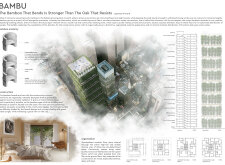5 key facts about this project
BAMBU is an architectural project that explores the relationship between nature and urban life, situated within a busy cityscape. Inspired by the growth patterns of bamboo, the design reflects ideas of modular construction and community engagement. It aims to create a blend of residential and communal spaces that enhance the living experience of its residents.
Concept Development
- The concept behind BAMBU is based on mimicking the rapid vertical growth of bamboo, which is characterized by modular and repetitive structural phases. This design strategy not only ensures the stability of the building but also creates diverse spaces within it. By incorporating social hubs on several floors, the project encourages interactions among residents, fostering a sense of community even in a tall structure.
Facade Design
- The facade acts as a dynamic element of the building, adapting as construction progresses. It features an organic appearance that protects against environmental factors while providing visual cohesion reminiscent of bamboo’s structure. The segmented design, with its distinct nodes and internodes, serves as both a visual element and a practical feature, aiding in the building's response to wind and sunlight.
Interior Functionality
- The interior spaces in BAMBU are crafted to enhance natural light and comfort. The modular floor plan allows for flexible uses, providing residents with areas for living and working. Accessible community loggias incorporate greenery and gardening options, prompting outdoor interactions and strengthening the link between inside and outside spaces.
Material Consideration
- The materials used in BAMBU include wood, specifically bamboo, along with glass and steel. These materials are chosen for their durability and sustainability, fitting the project’s ecological approach. The inclusion of bamboo not only reinforces the structural design but also highlights the aim to incorporate natural elements into urban living.
The design creates an inviting atmosphere where occupants can engage with their surroundings. Large windows and open spaces connect residents to the urban landscape, enhancing the overall experience of living where nature and architecture converge.



















































